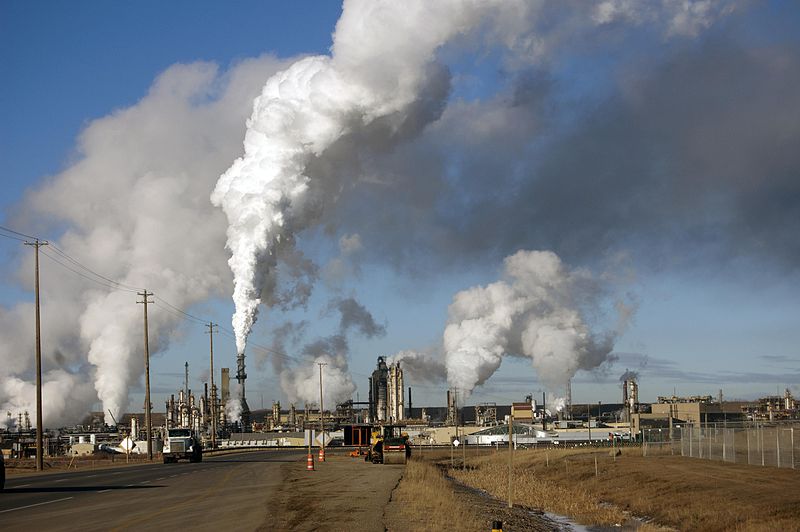The government of Alberta announced a $7 million contribution to Canadian oil giant Cenovus to study the possibility of using small modular nuclear reactors (SMR) as part of the province’s effort to decarbonize oil sands production.
Alberta Minister of Environment and Protected Areas Rebecca Schulz made the announcement Tuesday at the World Petroleum Congress in Calgary. Schulz was joined by Justin Riemer, CEO of Emissions Reduction Alberta (ERA), and Laura Kilcrease, CEO of Alberta Innovates. ERA’s Technology Innovation and Emissions Reduction (TIER) fund is financing the project.
Cenovus says the study will take several years and cost a total of $26 million. It will focus on the feasibility of using nuclear power as an energy source to power steam assisted gravity drainage process, also known as SAGD.
“The type of oil sands facility that we run at Cenovus is steam assisted gravity drainage,” said Rhona DelFrari, chief sustainability officer and executive vice resident of Stakeholder Engagement with Cenovus Energy.
“You use steam to inject it deep underground to loosen the oil so that you can pump it up,” she said. Almost all of the emissions created in this type of oil sands facility are from boiling water, she continued. “So you would be eliminating the emissions because you’re eliminating the burning of natural gas to oil, the water to create the steam.”
DelFrari then clarified that this would only eliminate emissions from operations, not consumption of the end product.
Much of Canada’s anticipated future oil production is expected to come from SAGD, an enhanced oil recovery technology in which steam is used to reduce the viscosity of oil sands, facilitating its extraction. The process currently uses large quantities of natural gas, available in situ, which produces considerable carbon dioxide emissions. Additional applications of nuclear power could include energy for oil sands operations generally speaking, as well as creating hydrogen from natural gas to then upgrade bitumen into synthetic crude, also known as syncrude.
“This is symptomatic of a government that doesn’t have a real climate plan and is doubling down, trying to keep the world stuck in the past century, with ever expanding oil and gas consumption, and ignoring the costs to people and the climate,” said Tom Green, senior climate policy advisor with the David Suzuki Foundation.”
At several points in her announcement, Schultz described SMRs as an emissions-reducing technology, or that it would help the province attain carbon neutrality by 2050.
Nuclear ‘Weapon of Choice’ for Big Oil
Experts are not as optimistic, pointing out that any technology used to maintain or increase oil sands production will not reduce emissions overall.
“Nuclear is the weapon of choice for big oil,” said Dr. Paul Dorfman, chair of the Nuclear Consulting Group and visiting fellow with the Science Policy Research Unit at the University of Sussex. Dorfman notes that SMRs are still very much in development, and they have long development periods, even when they have the approval of governments that are supportive of the development of new nuclear power stations.
In her statement, Schulz said that while her government knows any future adoption of SMRs “would absolutely require extensive regulatory and engagement process,” the government of Alberta is “currently working to ensure the regulatory framework is in place and ready should private industry pursue this technology.”
Schulz also stated that the government of Alberta and Canada’s federal government have started working on a regulatory framework for small modular reactor technology. Dorfman cautions that, even with a favorable regulatory environment, a recent British impact assessment report on developing new nuclear technology shows the process still requires a construction period of 13 to 17 years, and identifies the considerable risk this places on private enterprise and investors. Dorfman argues that the long development period for SMRs, and nuclear energy in general, may be advantageous to the oil industry, as they can continue producing during the extended regulatory and research and development periods.
“This is another public handout from the Government of Alberta to an extremely profitable company,” said Julia Levin, associate director, National Climate at Environmental Defence, a Canadian environmental advocacy organization. “SMRs appeal to oil and gas companies as a way to delay the energy transition, given how speculative the technology is.”
“The writing is on the wall though,” Levin added. “Even the head of the International Energy Agency has said we’re approaching the end of the fossil fuel era.” Levin said Alberta should be going all-in on renewable energy, rather than placing a moratorium on new clean projects. “With wildfires still burning in the province, it is irresponsible to continue subsidizing the companies fueling the climate crisis,” she noted
This sentiment was echoed by Green.
“The oil and gas industry has been incredibly profitable as of late,” Green said. According to the Pembina Institute’s Waiting to Launch mid-year update, Cenovus is on track for over 10 billion in profits from 2022 and the first two quarters of 2023, he noted.
“It doesn’t need a $7 million handout to study an expensive, unproven technology with its own host of problems,” Green added. “None of the modeling shows that building SMRs is the most cost-effective way to reduce the oil and gas sector’s emissions.”
Green explained that the International Energy Agency’s Executive Director Fatih Birol pointed out in May that the oil and gas industry has the technologies, the money, and the know-how to cut its emissions by 60 percent by 2030. “And it has the responsibility to do so,” he said. “This is a moment of truth: If the oil and gas industry wants to be taken seriously … it has to clean up its act.”
Subscribe to our newsletter
Stay up to date with DeSmog news and alerts







